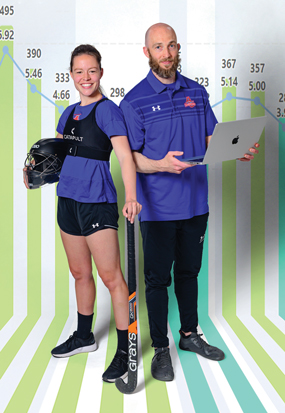
One at a time, AU men’s soccer players crouch down, summon their strength, and spring skyward.
In a corner of the weight room in Jacobs Fitness Center, the student-athletes take turns performing three of their best vertical jumps. After each vault, they land with a thud on black force plates that record their weight, velocity, and vertical leap.
Alex Lee, AU’s assistant athletic director for athletic performance, studies the metrics as they appear on his computer—each data point an indicator of the power behind every shot and header the Eagles take on the pitch.
“I look at it as if every athlete is clay that I can make more malleable,” he says. “Then it’s up to the coaches to mold that athlete into a better basketball or soccer player.”
AU Athletics has embraced physiological analytics and technology, shaping clay into champions. All 16 varsity programs use jump pads, force plates, and other handheld tools to collect data during practice sessions, which helps coaches optimize training, performance, and recovery.
When Lee was first introduced to strength and conditioning as a student intern at North Carolina State University in the early aughts, the field was in its infancy. Instruments that are now as standard as pads and cleats in collegiate athletic departments could then only be found in exercise science labs.
Today, Lee—AU’s assistant strength coach from 2013–14, who returned to the university in 2021 after a stint at the US Naval Academy—uses more than his eyes and intuition to measure the quality of workouts. “I’ve had to brush up on Newtonian physics a little bit,” he says with a smile.
In addition to tools in the weight room, many teams also sport wearable technology during practices and games. In 2015, field hockey’s Steve Jennings became the first AU head coach to outfit his players with the gear; last season, his squad switched to Catapult vests, which capture metrics on every sprint and pass. The vests track players’ heart rates, speed, and metabolic power, creating a baseline unique to each student-athlete that helps coaches calibrate performance and mitigate the risk of injury.
Field hockey goalkeeper Bryn Underwood, Kogod/BS ’24, SOC/MA ’26, (pictured) says the technology also helps home in on the differences between women and men in the same sport. “The more data we can collect, share, and analyze, the more we can protect female athletes and their bodies as we continue to reach elite levels of performance,” says the 2023 Patriot League Field Hockey Scholar-Athlete of the Year.
Jennings says having a world of data at his fingertips has been crucial to his program’s success. Coaches can segment metrics down to individual practice drills to understand how the team performed at certain points during a particular exercise and to ensure players are consistently game-ready.
“If you want to be successful, your training load and the intensity of training should match—if not [exceed]—what you’re facing in games,” Jennings says. “We’ve been able to show that in our preparation for the Patriot League Tournament and the NCAA tournament, we were at our peak for speed, distance covered, and game tempo.”
Data doesn’t lie—and the truth of it, Jennings says, is that technology “has produced a significant advantage for us being able to win championships.”